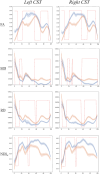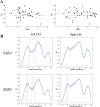An Investigation of Corticospinal Tract Microstructural Integrity in ARSACS Using a Profilometry MRI Analysis: Results From the PROSPAX Study
- PMID: 40241303
- PMCID: PMC12003562
- DOI: 10.1111/ene.70128
An Investigation of Corticospinal Tract Microstructural Integrity in ARSACS Using a Profilometry MRI Analysis: Results From the PROSPAX Study
Abstract
Background: Spasticity represents a core clinical feature of Autosomal Recessive Spastic Ataxia of Charlevoix-Saguenay (ARSACS) patients. Nonetheless, its pathophysiological substrate is poorly investigated. We assessed the microstructural integrity of the corticospinal tract (CST) using diffusion MRI (dMRI) via profilometry analysis to understand its possible role in the development of spasticity in ARSACS.
Materials and methods: In this multi-center prospective study, data of 37 ARSACS (M/F = 21/16; 33.4 ± 12.4 years) and 29 controls (M/F = 13/16; 42.1 ± 17.2 years) acquired within the PROSPAX consortium were collected from January 2021 to October 2022 and analyzed. Differences in terms of global CST microstructural integrity were probed, as well as a possible spatial distribution of the damage along the tract via profilometry analysis. Possible correlations between clinical severity, including the Spastic Paraplegia Rating Scale (SPRS), were also tested.
Results: A significant global involvement of the CST was found in ARSACS compared to controls (all tests with p < 0.001), with a spatially defined pattern of more pronounced microstructural integrity loss occurring right below and above the pons, a structure that was also confirmed to be thickened in these patients (p < 0.001). A bilateral negative correlation emerged between the microstructural integrity of the CST and clinical indices of spasticity expressed via SPRS (p = 0.02 for both CSTs).
Conclusion: A clinically meaningful microstructural involvement of CST is present in ARSACS patients, with a spatially defined pattern of damage occurring right below and above a thickened pons. An evaluation of the microstructure of this bundle might serve as a possible biomarker in this condition.
Keywords: ARSACS; ataxia; corticospinal tract; diffusion tensor imaging; magnetic resonance imaging.
© 2025 The Author(s). European Journal of Neurology published by John Wiley & Sons Ltd on behalf of European Academy of Neurology.
Conflict of interest statement
S.C. have received fees for Advisory Board by Amicus. All other co‐authors declare no conflicts of interest.
Figures





References
Publication types
MeSH terms
Supplementary concepts
Grants and funding
- 441409627/Deutsche Forschungsgemeinschaft (DFG, German Research Foundation)
- 825575/PROSPAX consortium under the frame of EJP RD, the European Joint Programme on Rare Diseases, under the EJP RD COFUND-EJP No
- GSA21G005/Fondazione Telethon and the Associazione ARSACS ODV - Italy
- FMS is partially supported by the Italian Ministry of Health, Ricerca Corrente 2024
LinkOut - more resources
Full Text Sources

